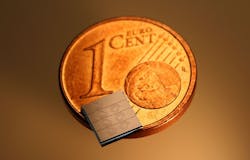Chip-based ring resonators generate compact optical frequency comb
Researchers funded by the Swiss National Science Foundation (SNSF) have successfully produced optical solitons—light waves that retain their shape—composed of a range of frequencies separated very precisely by the same distance, producing what physicists call a frequency comb as it resembles the regular spacing between the teeth of a comb.
RELATED ARTICLE: Frequency combs make their way to the masses
To generate the solitons, researchers at EPFL (Lausanne, Switzerland) and the Russian Quantum Center (Moscow, Russia) have used microresonators or ring resonators. "These microscopic ring-shaped structures are made from very fine silicon nitride," explains Tobias Kippenberg, the EPFL group leader. "They are capable of storing for a few nanoseconds the light of the laser to which they are coupled. This period of time is sufficient for the light to circumnavigate the ring thousands of times and to accumulate there, which strongly increases the intensity of the light."
The interaction between the microresonator and the light becomes nonlinear. The laser, which is normally continuous by nature, is converted into ultrashort pulses: solitons.
By adapting the parameters for manufacturing microresonators, the EPFL researchers additionally managed to generate a so-called soliton Cherenkov radiation. This broadens the frequency spectrum: the comb contains a greater number of teeth. Published in Science, the results have set a new record for this type of structure.1 The frequencies generated now extend over two thirds of an octave compared with the frequency of the laser.
"These results represent a promising advance for applications that require many widely spaced frequencies," says Kippenberg. In the context of optical communications, one single laser would be enough to create a range of individual frequencies which could separately carry information. Chemical spectroscopy and atomic timekeeping are other potential fields of application. "We have filed a patent, since there is potential for further technological developments," says Kippenberg.
Frequency combs, a discovery by Theodor Hänsch and John Hall that won them a Nobel Prize for Physics in 2005, are generally created using very large lasers. "The ability to produce optical frequency combs using small chips represents an interesting advance for making them more user-friendly," says Tobias Kippenberg.
REFERENCE
1. V. Brasch et al., “Photonic chip–based optical frequency comb using soliton Cherenkov radiation,” Science 10.1126/science.aad4811 (2015).
SOURCE: SNSF; http://www.snf.ch/en/researchinFocus/newsroom/Pages/news-160107-press-release-microresonators-solitons.aspx
About the Author

Gail Overton
Senior Editor (2004-2020)
Gail has more than 30 years of engineering, marketing, product management, and editorial experience in the photonics and optical communications industry. Before joining the staff at Laser Focus World in 2004, she held many product management and product marketing roles in the fiber-optics industry, most notably at Hughes (El Segundo, CA), GTE Labs (Waltham, MA), Corning (Corning, NY), Photon Kinetics (Beaverton, OR), and Newport Corporation (Irvine, CA). During her marketing career, Gail published articles in WDM Solutions and Sensors magazine and traveled internationally to conduct product and sales training. Gail received her BS degree in physics, with an emphasis in optics, from San Diego State University in San Diego, CA in May 1986.
